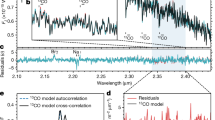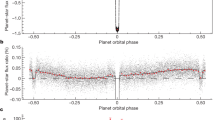Abstract
The interior structure of the Sun can be studied with great accuracy using observations of its oscillations, similar to seismology of the Earth. Precise agreement between helioseismological measurements and predictions of theoretical solar models1 has been a triumph of modern astrophysics. A recent downward revision by 25–35 per cent of the solar abundances of light elements such as C, N, O and Ne (ref. 2) has, however, broken this accordance: models adopting the new abundances incorrectly predict the depth of the convection zone, the depth profiles of sound speed and density, and the helium abundance1,3. The discrepancies are far beyond the uncertainties in either the data or the model predictions4. Here we report neon-to-oxygen ratios measured in a sample of nearby solar-like stars, using their X-ray spectra. The abundance ratios are all very similar and substantially larger than the recently revised solar value. The neon abundance in the Sun is quite poorly determined. If the Ne/O abundance in these stars is adopted for the Sun, the models are brought back into agreement with helioseismology measurements5,6.
This is a preview of subscription content, access via your institution
Access options
Subscribe to this journal
Receive 51 print issues and online access
$199.00 per year
only $3.90 per issue
Buy this article
- Purchase on Springer Link
- Instant access to full article PDF
Prices may be subject to local taxes which are calculated during checkout



Similar content being viewed by others
References
Bahcall, J. N., Basu, S., Pinsonneault, M. & Serenelli, A. M. Helioseismological implications of recent solar abundance determinations. Astrophys. J. 618, 1049–1056 (2005)
Asplund, M., Grevesse, N., Sauval, J. The solar chemical composition. Preprint at http://arxiv.org/abs/astro-ph/0410214 (2004).
Basu, S. & Antia, H. M. Constraining solar abundances using helioseismology. Astrophys. J. Lett. 606, L85–L88 (2004)
Bahcall, J. N., Serenelli, A. M. & Basu, S. New solar opacities, abundances, helioseismology, and neutrino fluxes. Astrophys. J. Lett. 621, L85–L88 (2005)
Antia, H. M. & Basu, S. The discrepancy between solar abundances and helioseismology. Astrophys. J. Lett. 620, L129–L132 (2005)
Bahcall, J. N., Basu, S., Serenelli, A. M. What is the neon abundance of the Sun? Preprint at http://arxiv.org/abs/astro-ph/0502563 (2005).
Bahcall, J. N., Serenelli, A. M. & Pinsonneault, M. How accurately can we calculate the depth of the solar convective zone? Astrophys. J. 614, 464–471 (2004)
Asplund, M., Nordlund, Å., Trampedach, R. & Stein, R. F. Line formation in solar granulation II. The photospheric Fe abundance. Astron. Astrophys. 359, 743–754 (2000)
Meyer, J.-P. The baseline composition of solar energetic particles. Astrophys. J. Suppl. 57, 151–171 (1985)
Anders, E. & Grevesse, N. Abundances of the elements—meteoritic and solar. Geochim. Cosmochim. Acta 53, 197–214 (1989)
Grevesse, N. & Sauval, A. J. Standard solar composition. Space Sci. Rev. 85, 161–174 (1998)
Drake, J. J. et al. Enhanced noble gases in the coronae of active stars. Astrophys. J. Lett. 548, L81–L85 (2001)
Acton, L. W., Catura, R. C. & Joki, E. G. Oxygen-to-neon abundance ratio in the solar corona. Astrophys. J. Lett. 195, L93–L95 (1975)
Canizares, C. R. et al. High-resolution X-ray spectra of Capella: initial results from the Chandra high-energy transmission grating spectrometer. Astrophys. J. Lett. 539, L41–L44 (2000)
Sanz-Forcada, J., Favata, F. & Micela, G. Coronal versus photospheric abundances of stars with different activity levels. Astron. Astrophys. 416, 281–290 (2004)
Feldman, U. & Laming, J. M. Element abundances in the upper atmospheres of the Sun and stars: update of observational results. Phys. Scr. 61, 222–252 (2000)
Drake, J. J. Chemical fractionation and abundances in coronal plasma. Adv. Space Res. 32, 945–954 (2003)
Güdel, M. X-ray astronomy of stellar coronae. Astron. Astrophys. Rev. 12, 71–237 (2004)
Audard, M., Güdel, M., Sres, A., Raassen, A. J. J. & Mewe, R. A study of coronal abundances in RS CVn binaries. Astron. Astrophys. 398, 1137–1149 (2003)
Schmelz, J. T., Saba, J. L. R., Ghosh, D. & Strong, K. T. Anomalous coronal neon abundances in quiescent solar active regions. Astrophys. J. 473, 519–532 (1996)
Murphy, R. J., Ramaty, R., Reames, D. V. & Kozlovsky, B. Solar abundances from gamma-ray spectroscopy—comparisons with energetic particle, photospheric, and coronal abundances. Astrophys. J. 371, 793–803 (1991)
Ramaty, R., Mandzhavidze, N., Kozlovsky, B. & Murphy, R. J. Solar atmospheric abundances and energy content in flare accelerated ions from gamma-ray spectroscopy. Astrophys. J. Lett. 455, L193–L196 (1995)
Schmelz, J. T. Elemental abundances of flaring solar plasma—Enhanced neon and sulfur. Astrophys. J. 408, 373–381 (1993)
Frisch, P. C. & Slavin, J. D. The chemical composition and gas-to-dust mass ratio of nearby interstellar matter. Astrophys. J. 594, 844–858 (2003)
Henry, R. B. C. & Worthey, G. The distribution of heavy elements in spiral and elliptical galaxies. Publ. Astron. Soc. Pacif. 111, 919–945 (1999)
Garcia-Alvarez, D. et al. The FIP effect on late-type stellar coronae: from dwarfs to giants. Astron. Astrophys. Soc. High Energy Astrophysics Division 8, 10.03 (2004)
Ness, J., Brickhouse, N. S., Drake, J. J. & Huenemoerder, D. P. Modeling the Ne IX triplet spectral region of Capella with the Chandra and XMM-Newton gratings. Astrophys. J. 598, 1277–1289 (2003)
Kashyap, V. & Drake, J. J. PINTofALE: Package for the interactive analysis of line emission. Bull. Astron. Soc. India 28, 475–476 (2000)
Mazzotta, P., Mazzitelli, G., Colafrancesco, S. & Vittorio, N. Ionization balance for optically thin plasmas: rate coefficients for all atoms and ions of the elements H to NI. Astron. Astrophys. Suppl. 133, 403–409 (1998)
Young, P. R. et al. CHIANTI-An atomic database for emission lines. VI. proton rates and other improvements. Astrophys. J. Suppl. 144, 135–152 (2003)
Acknowledgements
We thank G. Share, R. Murphy, W. Ball and D. Garcia-Alvarez for discussions and comments. J.J.D. was supported by a NASA contract to the Chandra X-ray Center. P.T. was supported by a Chandra award issued by the Chandra X-ray Center, which is operated by SAO for and on behalf of NASA. J.J.D. thanks the NASA AISRP for providing financial assistance for the development of the PINTofALE package.
Author information
Authors and Affiliations
Corresponding author
Ethics declarations
Competing interests
Reprints and permissions information is available at npg.nature.com/reprintsandpermissions. The authors declare no competing financial interests.
Supplementary information
Supplementary Data
A document containing a more complete list of some existing measurements of the Ne/O abundance ratio in the solar outer atmosphere, together with citations to the original sources. (PDF 21 kb)
Rights and permissions
About this article
Cite this article
Drake, J., Testa, P. The ‘solar model problem’ solved by the abundance of neon in nearby stars. Nature 436, 525–528 (2005). https://doi.org/10.1038/nature03803
Received:
Accepted:
Issue Date:
DOI: https://doi.org/10.1038/nature03803
This article is cited by
-
The Heliosphere and Local Interstellar Medium from Neutral Atom Observations at Energies Below 10 keV
Space Science Reviews (2022)
-
Solar structure and evolution
Living Reviews in Solar Physics (2021)
-
Supernova Remnants in the Hα and Hβ Lines
Astrophysics (2017)
-
What Have We Learned from Helioseismology, What Have We Really Learned, and What Do We Aspire to Learn?
Solar Physics (2013)
-
Properties of Energetic Ions in the Solar Atmosphere from γ-Ray and Neutron Observations
Space Science Reviews (2011)
Comments
By submitting a comment you agree to abide by our Terms and Community Guidelines. If you find something abusive or that does not comply with our terms or guidelines please flag it as inappropriate.



